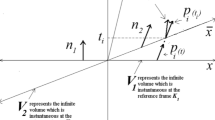Abstract
We address to the Poynting theorem for the bound (velocity-dependent) electromagnetic field, and demonstrate that the standard expressions for the electromagnetic energy flux and related field momentum, in general, come into the contradiction with the relativistic transformation of four-vector of total energy–momentum. We show that this inconsistency stems from the incorrect application of Poynting theorem to a system of discrete point-like charges, when the terms of self-interaction in the product \({\varvec{j}} \cdot {\varvec{E}}\) (where the current density \({\varvec{j}}\) and bound electric field \({\varvec{E}}\) are generated by the same source charge) are exogenously omitted. Implementing a transformation of the Poynting theorem to the form, where the terms of self-interaction are eliminated via Maxwell equations and vector calculus in a mathematically rigorous way (Kholmetskii et al., Phys Scr 83:055406, 2011), we obtained a novel expression for field momentum, which is fully compatible with the Lorentz transformation for total energy–momentum. The results obtained are discussed along with the novel expression for the electromagnetic energy–momentum tensor.


Similar content being viewed by others
Notes
Below, in Sect. 3, we clarify the limits of applicability of this approximation.
Here we stress that the well-known (and unambiguous) definition of EM momentum (10) results from the standard expression for the EM energy–momentum tensor (1). We also mention that the Poynting theorem (7) [i.e. Eq. (2) at \(\nu =0]\) itself does not, in general, uniquely defines the flux density \({\varvec{S}}\) of EM field and the related field momentum density \({\varvec{p}}_{EM}={\varvec{S}}/c^{2}\), due to some freedom in the choice of \({\varvec{S}}\), maintaining the divergence \(\nabla \cdot {\varvec{S}}\) unchanged. At the same time, one should stress that any modification of \({\varvec{S}}\) in the framework of the indicated limitation must be carried out along with the appropriate modification of EM energy–momentum tensor (1), which was never proposed to the moment before our paper [20], see Sect. 3.
In general, the magnetic field of the plates is not equal to zero in the frame K near the capacitor’s boundary, where the leakage electric field exists. However, the straightforward estimation shows that the component of momentum of such a leakage field is much less than (7), and cannot resolve the issue. Below we show that the contribution of momentum of leakage EM field to the total momentum of capacitor in the frame K has the order of magnitude (\(v/c)^{4}\).
This is, in general, not the case for the Coulomb gauge \(( {\nabla \cdot {\varvec{A}}=0})\), where manipulations with the tensor (53) occur more complicated; at the same time, the motional and continuity equations occur the same, like in the Lorenz gauge.
References
Lorentz, H.A.: The Theory of Electrons, 2nd edn. Dover, New York (1952)
Abraham, M.: Prinzipien der dynamik des electrons. Ann. Phys. 10, 105–179 (1903)
Dirac, P.A.M.: Classical theory of radiating electrons. Proc. R. Soc. Lond. A167, 148–169 (1938)
Born, M., Infeld, L.: Foundations of a new field theory. Proc. R. Soc. Lond. A144, 425–451 (1934)
Wheeler, A., Feynman, R.P.: Interaction with the absorber as the mechanism of radiation. Rev. Mod. Phys. 17, 157–162 (1945)
Rohrlich, F.: Classical Charged Particles. Addison-Wesley, Reading, Mass (1965)
Landau, L.D., Lifshitz, E.M.: The Classical Theory of Fields, 2nd edn. Pergamon Press, New York (1962)
Jackson, J.D.: Classical Electrodynamics, 3rd edn. Wiley, New York (1998)
Panofsky, W.K.H., Phillips, M.: Classical Electricity and Magnetism, 2nd edn. Addison-Wesley, Reading, Mass (1962)
Teitelboim, C., Villarroel, D., van Weert, ChG: Classical electrodynamics of retarded fields and point particles. Riv. Nuovo Cimento 3, 1–64 (1980)
Plass, G.N.: Classical electrodynamic equations of motion with radiative reaction. Rev. Mod. Phys. 33, 37–62 (1961)
Campos, I., Jiménez, J.L.: About Poynting’s theorem. Eur. J. Phys. 13, 117–121 (1992)
Poincaré, H.: Rendiconti Circolo Matematico Palermo 21, 129 (1906). (English translation with modern notation in Schwartz, H.M.: Am. J. Phys. 40, 862 (1972))
Kholmetskii, A.L., Missevitch, O.V., Yarman, T.: “4/3 problem”, Poynting theorem and electromagnetic energy–momentum tensor. Can. J. Phys. 93(999), 1–7 (2014)
Yaghjian, A.D.: Relativistic Dynamics of a Charged Sphere. Springer, Berlin (1992)
Schwinger, J.: Electromagnetic mass revisited. Found. Phys. 13, 373–383 (1983)
Singal, A.K.: Energy–momentum of the self-fields of a moving charge. J. Phys. A 25, 1605–1620 (1992)
Blinder, S.M.: Singularity-free electrodynamics for point charges and dipoles: a classical model for electron self-energy and spin Eur. J. Phys. 24, 271–276 (2003)
Medina, R.: Radiation reaction of a classical quasi-rigid extended particle. J. Phys. A 39, 3801–3816 (2006)
Kholmetskii, A.L., Missevitch, O.V., Yarman, T.: Continuity equations for bound electromagnetic field and electromagnetic energy–momentum tensor. Phys. Scr. 83, 055406-1–055406-8 (2011)
Møller, C.: The Theory of Relativity. Clarendon Press, Oxford (1973)
McDonald, K.: http://www.hep.princeton.edu/~cdonald/examples/cap_stress.pdf
Shockley, W., James, R.P.: Try simplest cases discovery of “hidden momentum” forces on “magnetic currents”. Phys. Rev. Lett. 18, 876–879 (1967)
Aharonov, Y., Pearle, P., Vaidman, L.: Comment on ’Proposed Aharonov-Casher effect: another example of Aharonov-Bohm effect arising from a classical lag’. Phys. Rev. A 37, 4052–4055 (1988)
Kholmetskii, A.L., Missevitch, O.V., Smirnov-Rueda, R., Ivanov, R., Chubykalo, A.E.: Experimental test on the applicability of the standard retardation conditions to bound magnetic fields. J. Appl. Phys. 101, 023532 (2007)
Kholmetskii, A.L., Missevitch, O.V., Smirnov-Rueda, R.: Measurement of propagation velocity of bound electromagnetic fields in near zone. J. Appl. Phys. 102, 013529 (2007)
Missevitch, O.V., Kholmetskii, A.L., Smirnov-Rueda, R.: Anomalously small retardation of bound (force) field in antenna near zone. Europhys. Lett. 93, 64004-1–64004-6 (2011)
Acknowledgments
We thank the anonymous referee for the important points he raised, which had been useful for the improvement of the final version of the paper.
Author information
Authors and Affiliations
Corresponding author
Rights and permissions
About this article
Cite this article
Kholmetskii, A., Missevitch, O. & Yarman, T. Poynting Theorem, Relativistic Transformation of Total Energy–Momentum and Electromagnetic Energy–Momentum Tensor. Found Phys 46, 236–261 (2016). https://doi.org/10.1007/s10701-015-9963-9
Received:
Accepted:
Published:
Issue Date:
DOI: https://doi.org/10.1007/s10701-015-9963-9




